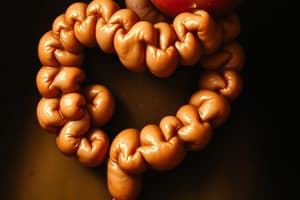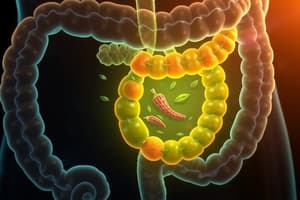Podcast
Questions and Answers
Which carbohydrate is NOT digested by enzymes in the human gut?
Which carbohydrate is NOT digested by enzymes in the human gut?
- Lactose
- Cellulose (correct)
- Sucrose
- Starch
What is the most commonly ingested form of carbohydrate?
What is the most commonly ingested form of carbohydrate?
- Starch (correct)
- Cellulose
- Lactose
- Sucrose
Which of the following is an incorrect pairing of carbohydrate and its source?
Which of the following is an incorrect pairing of carbohydrate and its source?
- Lactose - Vegetables (correct)
- Cellulose - Plant cell walls
- Starch - Potatoes
- Sucrose - Table sugar
If a person is described as 'lactose intolerant', they are unable to efficiently process which carbohydrate?
If a person is described as 'lactose intolerant', they are unable to efficiently process which carbohydrate?
Which of these is a disaccharide?
Which of these is a disaccharide?
Which of the following water-soluble vitamins is NOT absorbed passively?
Which of the following water-soluble vitamins is NOT absorbed passively?
The absorption of which water-soluble vitamin requires the intrinsic factor?
The absorption of which water-soluble vitamin requires the intrinsic factor?
Which cells of the stomach secrete the intrinsic factor necessary for vitamin absorption?
Which cells of the stomach secrete the intrinsic factor necessary for vitamin absorption?
Aside from Vitamin B12, which other vitamin requires a special mechanism and is not absorbed passively?
Aside from Vitamin B12, which other vitamin requires a special mechanism and is not absorbed passively?
A patient has a condition that inhibits the proper functioning of the oxyntic cells in their stomach. Which of the following vitamins might they have difficulty absorbing?
A patient has a condition that inhibits the proper functioning of the oxyntic cells in their stomach. Which of the following vitamins might they have difficulty absorbing?
Under what condition might the glucose level in chyme be particularly significant?
Under what condition might the glucose level in chyme be particularly significant?
Approximately how many grams of protein are digested and absorbed by the gut daily?
Approximately how many grams of protein are digested and absorbed by the gut daily?
What is directly implied about the rate of protein digestion and absorption in the gut?
What is directly implied about the rate of protein digestion and absorption in the gut?
Based on the content, if glucose levels in chyme become critical, what process does that directly affect?
Based on the content, if glucose levels in chyme become critical, what process does that directly affect?
Which statement best represents the data provided about protein digestion and absorption?
Which statement best represents the data provided about protein digestion and absorption?
What is the primary function of villi in the small intestine?
What is the primary function of villi in the small intestine?
Which of the following correctly describes villi?
Which of the following correctly describes villi?
What primarily supports the function of villi in absorbing nutrients?
What primarily supports the function of villi in absorbing nutrients?
Which characteristic of villi enhances their effectiveness for absorption?
Which characteristic of villi enhances their effectiveness for absorption?
Where are villi predominantly located in the digestive system?
Where are villi predominantly located in the digestive system?
What is the primary function of enzymes in digestion?
What is the primary function of enzymes in digestion?
Which of the following macromolecules is NOT broken down by enzymes during digestion?
Which of the following macromolecules is NOT broken down by enzymes during digestion?
What type of reaction do enzymes facilitate during digestion?
What type of reaction do enzymes facilitate during digestion?
Which statement about enzymes in digestion is accurate?
Which statement about enzymes in digestion is accurate?
How do enzymes enhance the process of digestion?
How do enzymes enhance the process of digestion?
Which part of the digestive system is primarily responsible for nutrient absorption?
Which part of the digestive system is primarily responsible for nutrient absorption?
What is the primary function of the esophagus in the digestive system?
What is the primary function of the esophagus in the digestive system?
Which of the following statements about nutrient absorption is correct?
Which of the following statements about nutrient absorption is correct?
Where in the digestive tract is the least absorption of nutrients likely to occur?
Where in the digestive tract is the least absorption of nutrients likely to occur?
What type of cells are primarily responsible for nutrient absorption in the small intestine?
What type of cells are primarily responsible for nutrient absorption in the small intestine?
Flashcards
Digestion
Digestion
The process of breaking down food into smaller molecules that the body can absorb and use for energy and building blocks.
Enzymes
Enzymes
Biological catalysts that speed up chemical reactions in the body, including the breakdown of food during digestion.
Carbohydrates
Carbohydrates
Sugars and starches, a major source of energy for the body.
Proteins
Proteins
Signup and view all the flashcards
Lipids
Lipids
Signup and view all the flashcards
Absorption
Absorption
Signup and view all the flashcards
Small Intestine
Small Intestine
Signup and view all the flashcards
Stomach
Stomach
Signup and view all the flashcards
Esophagus
Esophagus
Signup and view all the flashcards
Ileum
Ileum
Signup and view all the flashcards
What are villi?
What are villi?
Signup and view all the flashcards
Where are villi found?
Where are villi found?
Signup and view all the flashcards
What is the main function of villi?
What is the main function of villi?
Signup and view all the flashcards
What are microvilli?
What are microvilli?
Signup and view all the flashcards
How do nutrients travel after being absorbed by villi?
How do nutrients travel after being absorbed by villi?
Signup and view all the flashcards
Carbohydrate digestion
Carbohydrate digestion
Signup and view all the flashcards
Cellulose digestion
Cellulose digestion
Signup and view all the flashcards
Lactose digestion
Lactose digestion
Signup and view all the flashcards
Sucrose digestion
Sucrose digestion
Signup and view all the flashcards
Carbohydrate Absorption
Carbohydrate Absorption
Signup and view all the flashcards
Protein Digestion
Protein Digestion
Signup and view all the flashcards
Daily Protein Absorption
Daily Protein Absorption
Signup and view all the flashcards
High Glucose and Chyme
High Glucose and Chyme
Signup and view all the flashcards
Protein Breakdown
Protein Breakdown
Signup and view all the flashcards
Protein Absorption
Protein Absorption
Signup and view all the flashcards
Water-soluble Vitamin Absorption
Water-soluble Vitamin Absorption
Signup and view all the flashcards
Vit. B12 Absorption
Vit. B12 Absorption
Signup and view all the flashcards
Role of Oxyntic Cells
Role of Oxyntic Cells
Signup and view all the flashcards
Intrinsic Factor
Intrinsic Factor
Signup and view all the flashcards
Small Intestine: Water-soluble Vitamin Absorption
Small Intestine: Water-soluble Vitamin Absorption
Signup and view all the flashcards
Study Notes
Digestion and Absorption
- Digestion breaks down carbohydrates, proteins, and lipids using enzymes. Absorption is the process of taking these broken-down nutrients into the body using specialized epithelial cells.
- Most absorption happens in the small intestine, with some in the stomach and none in the esophagus, which primarily transports food.
- The colon absorbs water and electrolytes.
- The small intestine has specialized structures to increase nutrient absorption:
- Mucosal folds (Kerckring folds) increase surface area by three times.
- Villi increase surface area by another ten times.
- Microvilli on epithelial cells increase the surface area further by 20 times, which results in a total increase of 600 times.
Carbohydrate Digestion and Absorption
- Carbohydrates are ingested as starch, sucrose, lactose, and cellulose.
- Cellulose is not digested by enzymes in the gut.
- Digestion starts in the mouth with salivary alpha-amylase (ptyalin) partially breaking down starch into smaller glucose polymers and alpha limit dextrins.
- Pancreatic amylase further breaks down starch into maltose and maltotriose.
- Brush border enzymes (lactase, sucrase, and maltase) convert disaccharides into monosaccharides (glucose, galactose, and fructose).
- These monosaccharides are absorbed via sodium-dependent cotransport and facilitated diffusion.
Protein Digestion and Absorption
- Protein digestion begins in the stomach with pepsin, activated by hydrochloric acid (HCl).
- Pepsin breaks down proteins into large polypeptides.
- Further digestion in the small intestine using proteolytic enzymes (endopeptidases and exopeptidases) breaks down polypeptides into smaller peptides.
- These smaller peptides are broken down into amino acids by brush border peptidases.
- Amino acids are absorbed through sodium-dependent carriers.
Lipid Digestion and Absorption
- Lipid digestion begins in the small intestine with bile salts, which emulsify fats into small droplets.
- Pancreatic lipase and colipase break down triglycerides into monoglycerides and free fatty acids.
- These products, along with phospholipids, cholesterol, and bile salts, form micelles.
- Micelles facilitate the absorption of lipid products into the epithelial cells by diffusion.
- Inside the cells, monoglycerides and free fatty acids recombine to form triglycerides.
- Triglycerides aggregate with cholesterol, phospholipids, and proteins to form chylomicrons.
- Chylomicrons are transported via the lymphatic system.
Water and Electrolyte Absorption
- Water is absorbed passively through the epithelial cells in response to sodium absorption (osmosis).
- Sodium is actively absorbed in the small intestine and colon.
- Other electrolytes (e.g., chloride and potassium) are absorbed passively or actively, depending on the specific electrolyte.
Vitamin Absorption
- Water-soluble vitamins are absorbed passively, except for vitamin C, B1, and B12.
- Vitamin B12 requires intrinsic factor for absorption.
- Lipid-soluble vitamins (A, D, E, and K) follow a similar path as lipids (absorbed in micelles and chylomicrons).
Iron Absorption
- Iron absorption mainly occurs in the small intestine.
- Ferrous iron is more absorbable than ferric iron.
- Factors like vitamin C enhance iron absorption, while others (like phosphates, oxalates, phytic acid) inhibit it.
Studying That Suits You
Use AI to generate personalized quizzes and flashcards to suit your learning preferences.




